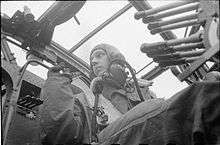No. 35 Squadron RAF
| No. XXXV (Madras Presidency) Squadron RAF | |
|---|---|
|
XXXV Squadron crest. | |
| Active |
1 February 1916 – 26 June 1919 1 March 1929 – 8 April 1940 5 November 1940 – 23 February 1950 1 September 1951 – 11 September 1961 1 December 1962 – 1 March 1982 |
| Country |
|
| Branch |
|
| Motto(s) |
Latin: Uno animo agimus ("We act with one accord") |
| Battle honours | Western Front, 1917-18*: Arras: Lys: Ypres, 1917*: Cambrai, 1917*: Somme, 1918*: Amiens: Biscay Ports, 1941-43: Fortress Europe, 1941-44*: German Ports, 1943: Ruhr, 1943-45*: Normandy, 1944*: Baltic, 1944: France & Germany, 1944-45*: Walcheren.Honours marked with an asterisk are those emblazoned on the Squadron Standard |
| Squadron codes |
WT Apr 1939 - Sep 1939 TL Nov 1940 - Feb 1951 FB Sep 1950 - Apr 1951 |
No. 35 Squadron (also known as No. XXXV (Madras Presidency) Squadron) was a squadron of the Royal Air Force.
History
World War I
No. 35 Squadron was formed on 1 February 1916 at Thetford, training as a Corps reconnaissance squadron. In January 1917 the squadron moved to France, equipped with the Armstrong Whitworth F.K.8, beginning operations during the Battle of Arras, working alongside the Cavalry Corps, throughout 1917 (which later resulted in the Pegasus winged horses head in the Squadrons crest).[1] It re-equipped with Bristol Fighters in the later part of 1918,[2] before returning to RAF Netheravon in March 1919 and then disbanding on 26 June 1919.[3]
Between the Wars
On 1 March 1929 the squadron reformed at Bircham Newton, and was initially equipped with Airco DH.9As, re-equipping with the Fairey IIIF in November that year. In 1932, its IIIFs were replaced by an improved development, the Fairey Gordon. As a response to the Italian invasion of Ethiopia, the squadron was posted to the Sudan in late 1935, returning to RAF Worthy Down in August 1936, and re-equipping with the Vickers Wellesley. On 12 April 1938 the squadron converted to the Fairey Battle.[4]
World War II


On the outbreak of World War II, No. 35 Squadron was designated a training unit, supplementing its Battles with Avro Ansons and Bristol Blenheims late in 1939.[5] The squadron disbanded after being absorbed into No. 17 OTU along with No. 90 Squadron at RAF Upwood, on 8 April 1940. It reformed on 5 November 1940 at RAF Linton-on-Ouse in Yorkshire as the first Handley Page Halifax squadron. In August 1942 it became a pathfinder unit, forming part of No. 8 Group at RAF Graveley. In March 1944 the squadron re-equipped with the Avro Lancaster.
Postwar
During 1946 the squadron participated in a goodwill tour of the United States, later returning to RAF Stradishall, due to Graveley's closure. The Lancasters were replaced by Avro Lincolns in September 1949, and the squadron later disbanded on 23 February 1950. On 1 September 1951 the squadron reformed at Marham equipped with the Boeing Washington.
In April 1954 the squadron re-equipped with its first jet powered aircraft type, the English Electric Canberra twin engined light bomber. The squadron again disbanded on 11 September 1961.

No. 35 Squadron reformed for the last time on 1 December 1962 at RAF Coningsby as part of RAF Bomber Command's V-bomber force, equipped with eight Vulcan B2 aircraft and Yellow Sun free-falling bombs in a high-altitude strategic bombing role, moving to RAF Cottesmore on 7 November 1964. When the WE.177B strategic bomb became available from mid-1966, eight were issued to No. 35 Squadron at Cottesmore.[6] These laydown bombs were specifically designed for the low-level penetration role, did not require a pre-release 'pop-up' manoeuvre, and improved the survivability of the squadron's Vulcans.
Following the transfer of responsibility for the nuclear deterrent to the Royal Navy the squadron joined the Near East Strike Force at RAF Akrotiri, Cyprus, still equipped with eight Vulcan B2s and eight WE.177 nuclear weapons and a variety of conventional weapons.[7] The squadron remained at Akrotiri with 9 Squadron's similarly equipped Vulcans assigned as part of the UK contribution to CENTO the Central Treaty Organisation, for use in the low-level penetration role until the end of 1974,[8][9] returning to RAF Scampton in January 1975 where the squadron disbanded for the last time on 1 March 1982.
See also
Notes
- ↑ Brookes 1979, pp.229–230.
- ↑ "No 31 – 35 Squadron Histories" Air of Authority – A History of RAF Organisation. Retrieved 22 March 2009.
- ↑ Brookes 1979,p.230.
- ↑ Brookes 1979, pp.230–231.
- ↑ Halley 1980, p. 67.
- ↑ RAF nuclear front line Order-of-Battle 1966–67
- ↑ RAF nuclear front line Order-of-Battle 1969
- ↑ RAF nuclear front line Order-of-Battle 1973–74
- ↑ Weapon overview @ www.nuclear-weapons.info/vw.htm#WE.177 Carriage
References
- Lake, Alan (1999). Flying units of the RAF. Shrewsbury: Airlife Publishing. ISBN 1-84037-086-6.
- Brookes, Andrew J. "Flying the Winged Horse – the history of No 35 Squadron RAF". Aircraft Illustrated, May 1979, Vol 12, No.5. pp. 229–233.
- Halley, James J. The Squadrons of the Royal Air Force. Tonbridge, Kent, UK: Air Britain (Historians), 1980. ISBN 0-85130-083-9.
- Stocker, Flt Lt Ted, DSO, DFC A Pathfinders war: An extraordinary tale of surviving over 100 bomber operations against all odds. London: Grubb Street, 2009. ISBN 978-1-906502-52-2.
- Humphrey Wynn. RAF Strategic Nuclear Deterrent Forces: their origins, roles and deployment 1946–1969. pps 128, 449–463. Pub MoD & HMSO. ISBN 0-11-772833-0
External links
| Wikimedia Commons has media related to No. 35 Squadron RAF. |
- Air of Authority
- Squadron history page on official RAF website
- Weapon overview @ www.nuclear-weapons.info/vw.htm#WE.177 Carriage
- RAF nuclear front line Order-of-Battle 1973–74
- RAF nuclear front line Order-of-Battle 1966–67
